Best Large Breed Puppy Foods
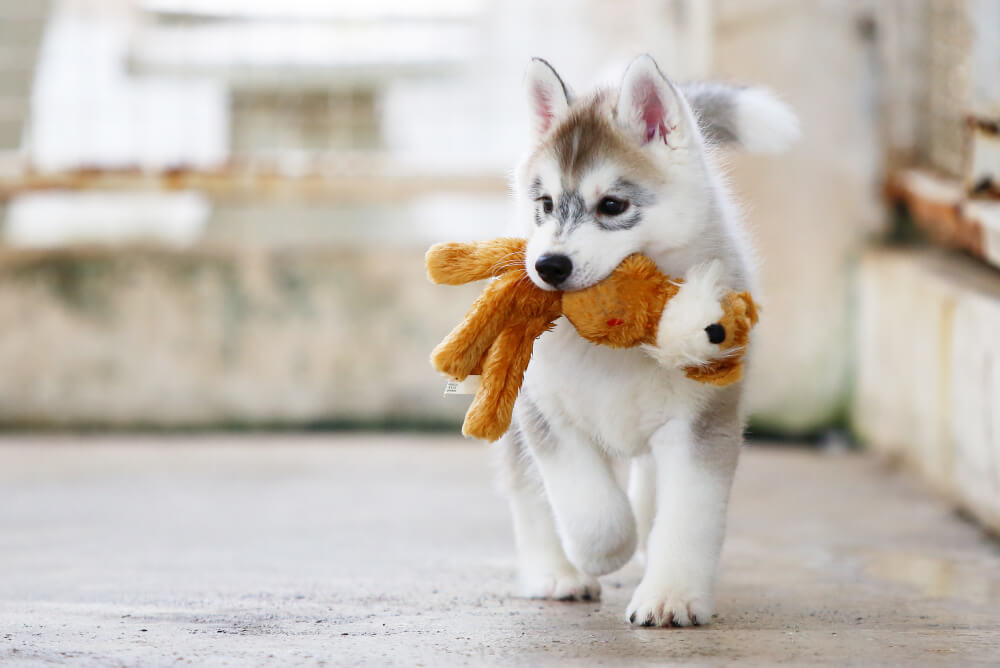
DogFoodAdvisor is reader supported See how
All reviews are 100% impartial but if you buy using links on this page, we may earn a referral fee.
Choosing the best food for your large breed puppy is one of the most important decisions you’ll ever make.
That’s because choosing the wrong puppy food… one that contains too much calcium… could cause permanent bone damage and hip disease… for large breeds.1 2
On this page… you’ll find The Dog Food Advisor’s 12 best large breed puppy foods. And we’ll answer the 7 most frequently asked questions we get about feeding large breed puppies.
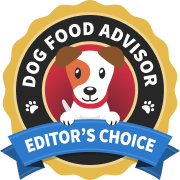
Best Large Breed Puppy Foods April 2024
Here are The Dog Food Advisor’s best large breed puppy foods for April 2024.
-
1. Wellness Complete Health Large Breed Puppy Food
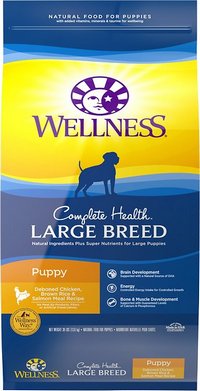
Complete Health Large Breed Puppy is one of 13 dry recipes included in our review of the Wellness Complete Health product line.
Complete Health Large Breed Puppy derives the bulk of its animal protein from fresh chicken as well as chicken meal and salmon meal. Our dry matter label analysis reveals the recipe contains 32% protein, 14% fat and 45% estimated carbs… with a fat-to-protein ratio of about 44%.
A safe, balanced calcium design from a trusted brand. Highly recommended.
Read our review of the full Wellness Complete Health Dog Food (Dry) range here
Main Ingredients Deboned chicken, chicken meal, peas, ground brown rice, salmon meal Texture Dry Type Grain-inclusive Protein Percentage 32% AAFCO Standards Growth Best For All puppies including large breeds -
2. Orijen Puppy Large
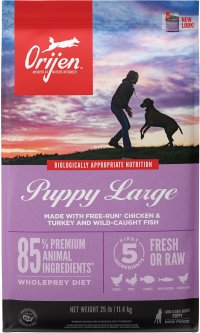
This Orijen formula is one of 9 dry recipes included in our review of the Orijen product line.
Orijen Puppy Large gets the dominant portion of its animal protein from deboned poultry and fresh fish. Our dry matter label analysis reveals the recipe contains 43% protein, 18% fat and 30% estimated carbs… creating a fat-to-protein ratio of about 41%.
A premium large breed puppy food. Highly recommended.
Read our review of the full Orijen Dog Food (Dry) range here
Main Ingredients Deboned chicken, deboned turkey, yellowtail flounder, whole eggs, whole atlantic mackerel Texture Dry Type Grain-free Protein Percentage 43% AAFCO Standards All Life Stages Best For All puppies including large breeds (also safe for adults) -
3. Nom Nom
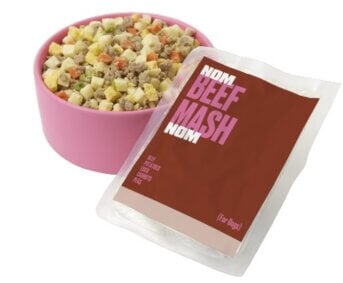
Beef Mash is one of 4 fresh-made recipes included in our review of the Nom Nom Dog Food product line.
Beef Mash derives the bulk of its animal protein from fresh ground beef. Our dry matter label analysis reveals the recipe contains 35% protein, 17% fat and 40% estimated carbs… with a fat-to-protein ratio of about 50%.
If you’ve ever wished you could serve your new puppy a fresh, home-cooked meal… but you don’t have the time for all the fuss… then Nom Nom makes a smart choice.
Made with top-quality, human-grade ingredients and a balanced recipe designed by a board-certified veterinary nutritionist (DACVN).
Not cheap. Enthusiastically recommended for all breed sizes… including puppies of larger breeds.
Read our review of the full Nom Nom Dog Food (Fresh) range here
Main Ingredients Ground beef, russet potatoes, eggs, carrots, peas Type Grain-free, fresh Protein Percentage 35% AAFCO Standards All Life Stages Best For All puppies including large breeds -
4. Jinx Dry Dog Food
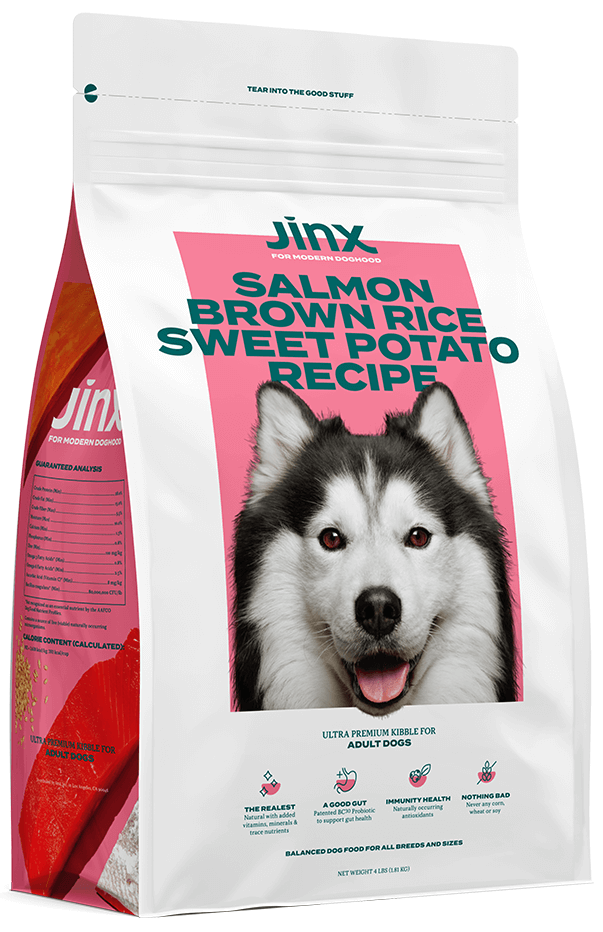
Salmon and Sweet Potato recipe is one of 4 dry recipes included in our review of the Jinx product line.
This Jinx recipe derives the bulk of its animal protein from fresh salmon. Dry matter label analysis reveals the recipe contains 30% protein, 16% fat and 46% estimated carbs… creating a fat-to-protein ratio of about 52%.
A fully-balanced, grain-inclusive dog food. Highly recommended.
Read our review of the full Jinx Dog Food (Dry) range here
Main Ingredients Salmon, pearled barley, ground peas, turkey meal, brown rice Texture Dry Type Grain-inclusive Protein Percentage 30% AAFCO Standards All Life Stages Best For All puppies including large breeds Sample buyer review...
Read more buyer reviews at ThinkJinx.com"I’ve had my pup on jinx for a year now and his tummy issues are no longer an issue. I’ve gone through so many brands before I found jinx and I’m so thankful I found them when I did."
-
5. Diamond Naturals Large Breed Puppy Formula
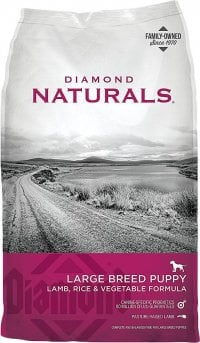
This Large Breed Puppy product is one of 13 dry recipes included in our review of the Diamond Naturals product line.
This Diamond Naturals formula gains the greatest share of its meat protein from fresh lamb and lamb meal. Our dry matter label analysis reveals the recipe contains 30% protein, 17% fat and 45% estimated carbs… resulting in a fat-to-protein ratio of about 56%.
A safe, budget-friendly option for your large breed puppy. Highly recommended.
Read our review of the full Diamond Naturals Dog Food (Dry) range here
Main Ingredients Lamb, lamb meal, whole grain brown rice, cracked pearled barley, ground white rice Texture Dry Type Grain-inclusive Protein Percentage 30% AAFCO Standards All Life Stages Best For All puppies including large breeds (also safe for adults) -
6. Blue Buffalo Life Protection Large Breed Puppy Food
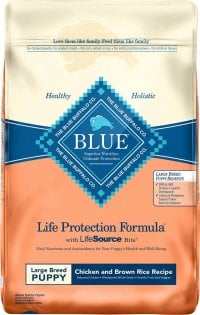
Life Protection Large Breed Puppy Chicken and Brown Rice is one of 21 dry recipes included in our review of the Blue Buffalo Life Protection product line.
This Blue Buffalo Life Protection recipe acquires the lion’s share of its meat protein from chicken and chicken meal. Our dry matter label analysis reveals the recipe contains 29% protein, 17% fat and 46% estimated carbs… which results in a fat-to-protein ratio of about 58%.
A top-rated, large breed growth option at an affordable price. Highly recommended.
Read our review of the full Blue Buffalo Dog Food range here
Main Ingredients Deboned chicken, chicken meal, brown rice, oatmeal, barley Texture Dry Type Grain-inclusive Protein Percentage 29% AAFCO Standards Growth Best For All puppies including large breeds -
7. Purina Pro Plan Large Breed Puppy Food
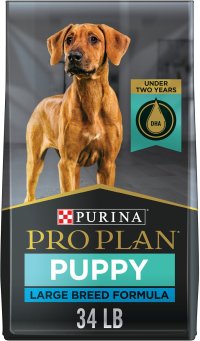
Large Breed Puppy is one of 10 dry recipes included in our review of the Purina Pro Plan Puppy product line.
Pro Plan Large Breed Puppy obtains the major portion of its meat protein from chicken. Our dry matter label analysis reveals the recipe contains 32% protein, 15% fat and 45% estimated carbs… which yields a fat-to-protein ratio of about 47%.
A time-proven field-tested formula with balanced calcium levels ideal for large and giant breed puppies. Recommended with confidence.
Read our review of the full Purina Pro Plan Dog Food range here
Main Ingredients Chicken, rice, corn gluten meal, whole grain corn, poultry by-product meal Texture Dry Type Grain-inclusive Protein Percentage 32% AAFCO Standards All Life Stages Best For All puppies including large breeds (also safe for adults) -
8. Hill’s Science Diet Large Breed Puppy
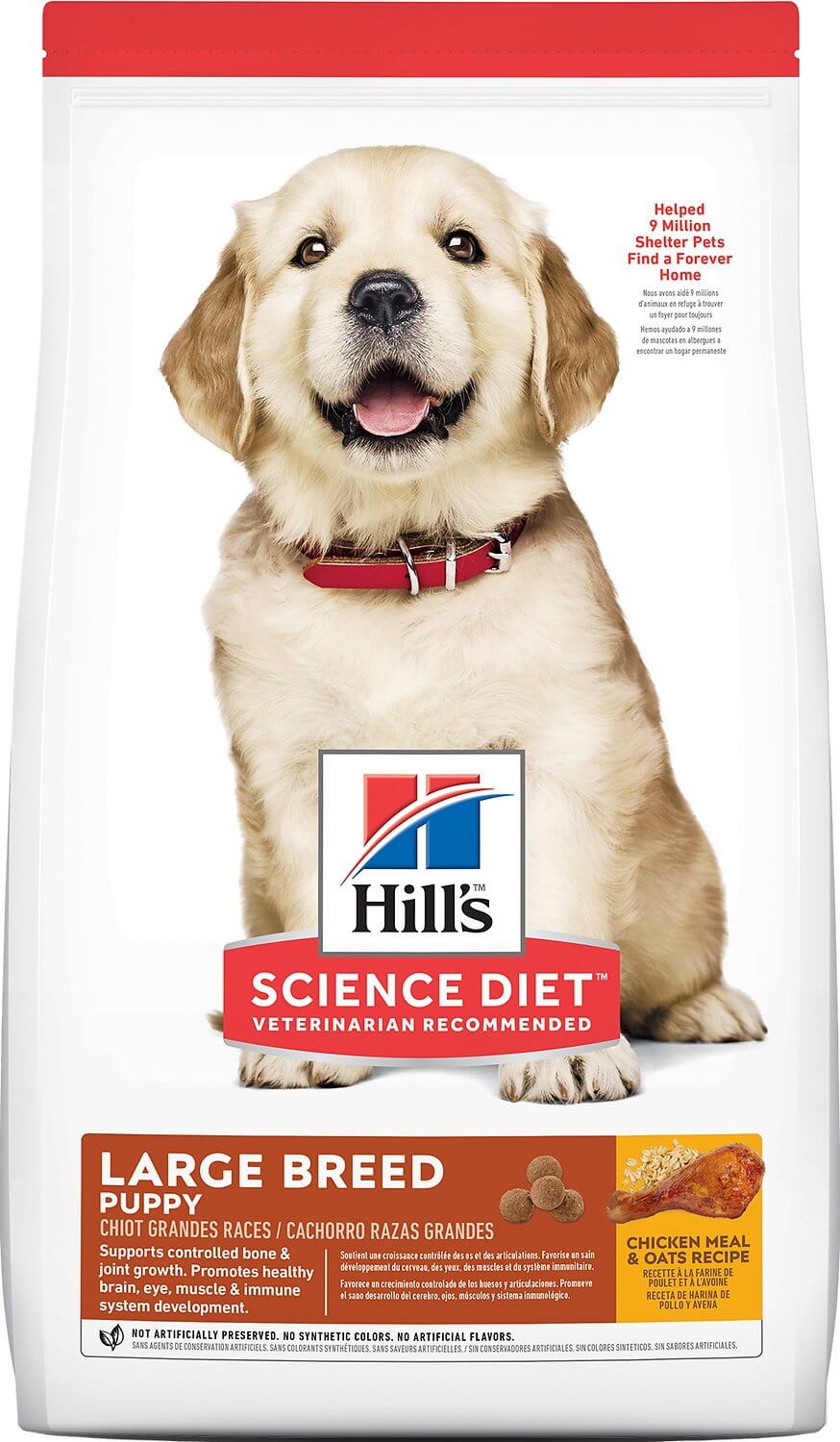
Hill’s Large Breed Puppy is one of 6 dry recipes included in our review of the Hill’s Science Diet product line.
Hill’s Science Diet Large Breed Puppy derives the dominant portion of its meat protein from chicken meal. Our dry matter label analysis reveals the recipe contains 30% protein, 14% fat and 48% estimated carbs… resulting in a fat-to-protein ratio of about 47%.
A classic, balanced design ideal for large breed puppies. Highly recommended.
Read our review of the full Hill’s Science Diet Puppy Food (Dry) range here
Main Ingredients Chicken meal, whole grain wheat, whole grain oats, whole grain sorghum, corn gluten meal Texture Dry Type Grain-inclusive Protein Percentage 30% AAFCO Standards Growth Best For All puppies including large breeds -
9. Taste of the Wild Pacific Stream Puppy
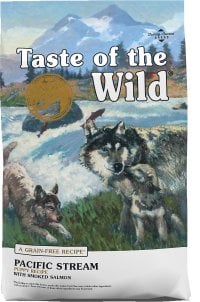
Pacific Stream Puppy is one of 9 dry recipes included in our review of the Taste of the Wild product line.
This Taste of the Wild puppy recipe derives the bulk of its animal protein from fresh salmon and ocean fish meal. Dry matter label analysis reveals the recipe contains 30% protein, 17% fat and 45% estimated carbs… with a fat-to-protein ratio of about 56%.
We like the inclusion of omega-3 DHA-rich fatty acid from salmon oil… which helps support brain and vision development in growing puppies.
This super-popular, scientifically-designed, all life stages formula is not only ideal for large breed puppies… it’s also reasonably priced. Highly recommended.
Read our review of the full Taste of the Wild Grain-Free Dog Food (Dry) range here
Main Ingredients Salmon, ocean fish meal, sweet potatoes, peas, potatoes Texture Dry Type Grain-free Protein Percentage 30% AAFCO Standards All Life Stages Best For All puppies including large breeds -
10. Eukanuba Large Breed Puppy
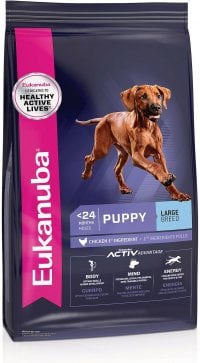
This Eukanuba puppy formula is one of 14 dry recipes included in our review of the Eukanuba product line.
Eukanuba Puppy Large Breed gains the principal part of its meat protein from fresh chicken. Our dry matter label analysis reveals the recipe contains 29% protein, 16% fat and 48% estimated carbs… resulting in a fat-to-protein ratio of about 55%.
A classic puppy design that’s especially popular among large breed enthusiasts. Highly recommended.
Read our review of the full Eukanuba Dog Food (Dry) range here
Main Ingredients Chicken, chicken by-product meal, corn, wheat, chicken fat Texture Dry Type Grain-inclusive Protein Percentage 29% AAFCO Standards Growth Best For All puppies including large breeds -
11. Royal Canin Large Puppy
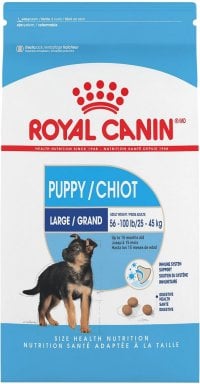
Royal Canin Large Puppy is one of 4 dry recipes included in our review of the Royal Canin product line.
This Royal Canin large breed puppy formula derives the dominant portion of its meat protein from chicken meal. Our dry matter label analysis reveals the recipe contains 31% protein, 16% fat and 45% estimated carbs… with a fat-to-protein ratio of about 52%.
A vet-designed, grain-inclusive formula ideal for large breed puppies. Highly recommended.
Read our review of the full Royal Canin Dog Food range here
Main Ingredients Corn, chicken by-product meal, wheat, wheat gluten, chicken fat Texture Dry Type Grain-inclusive Protein Percentage 31% AAFCO Standards Growth Best For All puppies including large breeds -
12. Nutro Natural Choice
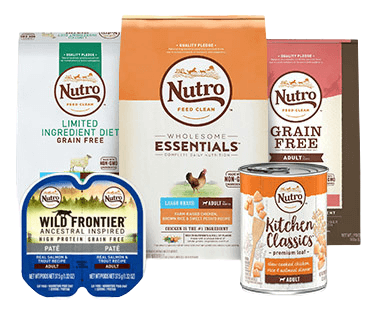
Nutro Natural Choice Large Breed Puppy is one of 19 dry recipes included in our review of the Nutro Natural Choice product line.
This Nutro Large Breed Puppy formula acquires much of its meat protein from fresh chicken. Dry matter label analysis reveals the recipe contains 29% protein, 16% fat and 48% estimated carbs… delivering a fat-to-protein ratio of about 54%.
A time-proven, fully-balanced large breed puppy food with added omega-rich fish oil. Highly recommended.
Read our review of the full Nutro Dog Food range here
Main Ingredients Chicken, chicken meal, whole grain sorghum, whole grain brown rice, whole grain barley Texture Dry Type Grain-inclusive Protein Percentage 29% AAFCO Standards Growth Best For All puppies including large breeds -
13. Chicken Soup for the Soul Large Breed Puppy Recipe
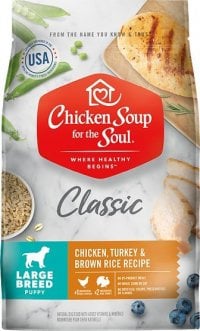
This Chicken Soup formula is one of 11 dry recipes included in our review of the Chicken Soup for the Soul product line.
Chicken Soup Large Breed Puppy derives the bulk of its animal protein from poultry and poultry meals. Our dry matter label analysis reveals the recipe contains 30% protein, 14% fat and 48% estimated carbs… resulting in a fat-to-protein ratio of about 48%.
A top-rated, large breed puppy food at an affordable price. Highly recommended.
Read our review of the full Chicken Soup for the Soul Dog Food (Dry) range here
Main Ingredients Chicken, turkey, chicken meal, turkey meal, cracked pearled barley Texture Dry Type Grain-inclusive Protein Percentage 30% AAFCO Standards All Life Stages Best For All puppies including large breeds (also safe for adults)
More Top Picks
To view more top dog foods by category… click the link below that best meets your personal feeding needs.
- How do I know if my puppy is a large breed?
- Why are large breeds more prone to hip dysplasia?
- How can I tell if a dog food is safe for large breed puppies?
- How much food should I feed my large breed puppy?
- How often should I feed my large breed puppy?
- When should I switch my puppy to adult food?
- Is it safe to let my puppy eat whenever she wants?
Frequently Asked Questions
How do I know if my puppy is a large breed?
The pet food industry3 defines a large breed puppy as one whose ADULT weight is expected to be more than 70 pounds.
However…
Since it’s not possible to know (in advance) your puppy’s adult weight before she’s fully grown…
It’s far safer to use a more conservative 50 pound definition for large breed dogs proposed by others.4 5 6 7 8
So…
If you expect your dog to weigh over 50 pounds when fully grown… then she’s considered a large breed puppy.
Why are large breeds more prone to hip dysplasia?
Hip disease in large breeds is caused by at least one of 3 proven factors:
So, since there’s nothing you can do to change your puppy’s genetics…
Be sure to avoid feeding too many calories or too much calcium… factors that can significantly increase your puppy’s risk of hip dysplasia.
How can I tell if a dog food is safe for large breed puppies?
According to the Association of American Feed Control Officials (AAFCO)…
The maximum amount of calcium recommended for large breed puppies is 4.5 grams of calcium per every 1000 kcal (calories) in the food… or 1.8% calcium.12
Keep in mind… the calcium content printed on the label does not reveal this amount.
That’s because those figures are based on MINIMUMS… which is NOT acceptable.
You want to know the EXACT amount of calcium obtained by actual lab testing (by asking the company)…
Or the MAXIMUM amount the manufacturer is willing to guarantee to you on the label.
Thankfully…
AAFCO now requires13 those calcium standards to be guaranteed in each product’s Nutritional Adequacy Statement on the packaging.
You should see “meets AAFCO nutrient profiles” for either “growth” or “all life stages”… AND the words… “including growth of large size dogs (animals weighing over 70 pounds)”.
Like this…
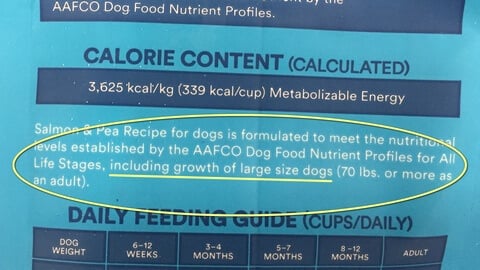
Since we never know the adult weight of a puppy before it’s fully grown, we recommend using a more conservative 50 pound definition for large breeds.
By the way…
All The Dog Food Advisor’s recommended large breed puppy foods meet these requirements. So, there’s no need for you to do any calculations yourself.
How much food should I feed my large breed puppy?
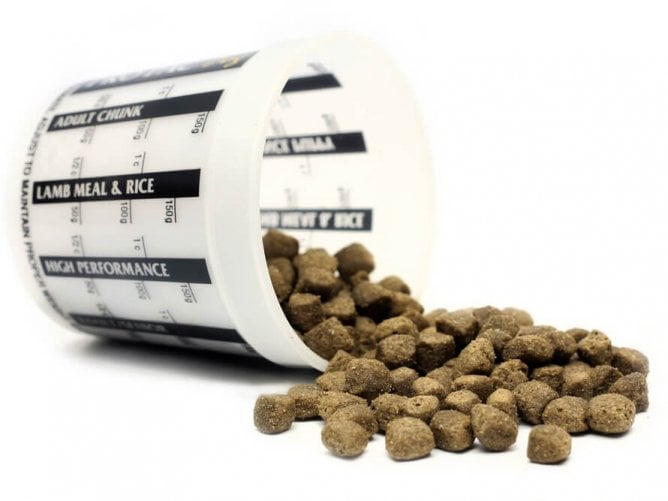
Determining how much to feed your large breed puppy is a process… NOT a one-time decision.
Since a large breed puppy consumes more food each day than a smaller breed…
And because each dry food contains a different number of calories per cup…
It’s best to start with the recommended feeding amount printed on the package. Then, adjust that amount… to keep your puppy at her ideal weight.
How often should I feed my large breed puppy?
Once you’ve determined how much to feed your puppy per day…
Simply divide that daily feeding amount into 3 or 4 smaller servings.
Then… feed those smaller portions to your puppy at regular intervals throughout the day.
To make it easy…
Try feeding your puppy whenever YOU eat… breakfast, lunch and dinner.
When should I switch my puppy to adult food?
Keep in mind…
Adult dog food can contain excessive amounts of calcium… which can make it unsafe for a puppy that’s still growing.
So… it’s important NOT to switch your puppy to adult food too soon.
With that in mind…
The best time to switch your puppy to adult food depends on her breed type.
The table below can help you determine when it’s safe to switch your large breed puppy to adult dog food.14 15
| Breed Type | Adult Weight | Switch to Adult |
|---|---|---|
| Large breed | 50 – 100 lbs | 12 – 18 months |
| Giant breed | Over 100 lbs | 18 – 24 months |
Keep in mind…
It’s much safer to keep your dog on puppy food too long… than to switch to an adult food too soon.
Is it safe to let my puppy eat whenever she wants?
‘Free choice’ is a popular feeding method whereby the food remains in the bowl all day long… so a puppy can eat… whenever she wants.
Sadly, many owners of large breed puppies mistakenly believe that this form of uncontrolled eating is the correct way to feed their pets.
But free choice feeding has been shown to cause a puppy to grow too fast… and lead to lasting bone damage.
A 1995 study of Great Danes revealed a significant increase in the risk of developing hip dysplasia when the puppies were fed free choice.16
In another study, one group of Labrador Retriever puppies was fed throughout life a restricted calorie diet… while a second was fed free choice.17
The restricted calorie group experienced a much lower risk of developing hip dysplasia later in life.
So, be sure to control the amount of food and the way you feed your puppy every day.





